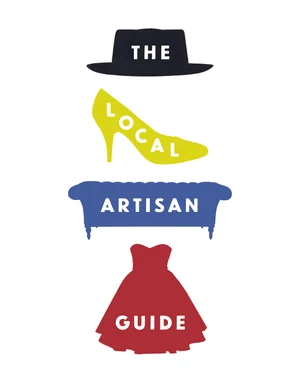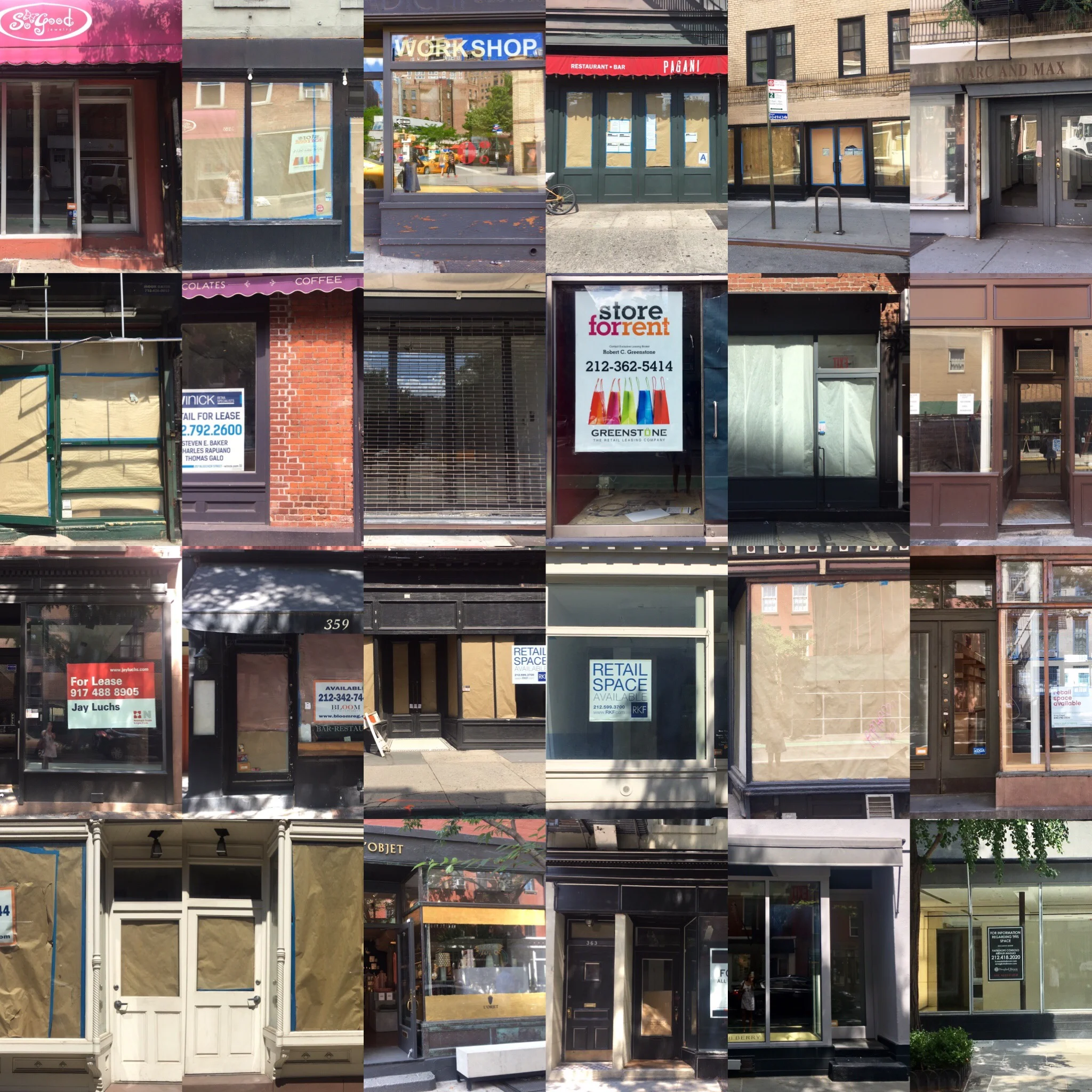In doing my research for The Local Artisan Guide, I spend many a day pounding the pavement, walking up and down streets looking for artisanal and smaller brands to feature in our guide. Lately I have been updating a multitude of closed stores which has set off an alarm for me regarding the neighborhoods that occupy both well known brands and smaller artisan brands. Most surprising is on Bleecker St. in the West Village where for the past fifteen years the area had morphed from a bohemian hotspot into a mini version of Fifth Avenue but now resembles a scene from a Rust Belt town.
A trip down Bleecker Street, West Village, New York City.
Walking down Bleecker St. in the West Village from where it starts on Hudson Ave. to Sixth Avenue is a very disconcerting sight. With the amount of closed storefronts you would think we are in an economic depression or the neighborhood has a high crime rate, however this is not so on both accounts. On separate blocks there is up to a 30 to 40% vacancy rate of shops that once occupied a very trendy, busy street. I have been observing the abandonment of Bleecker St. for the last few years but now with the amount of brands continuing to close there is no denying the ramifications and negative effects of gentrification.
To explain the situation it’s best to know the history of Bleecker Street. Bleecker St. in the West Village was once the epicenter of a very bohemian part of downtown New York City. Walking down the streets of this part of the city in the 80’s and 90’s you would find mom and pop shops, bodegas, delis, ethic restaurants, laundry mats and diners. There were local bookshops, cafes, jazz clubs and records shops dotted throughout Bleecker. It was the ideal formula of a real neighborhood where your daily needs were met. Rent for a shop back then could be an estimated $1500 a month making it affordable for small businesses to prosper.
It's not only retail stores that have been affected by the rent hike, restaurants too are closing.
Then in 1996 the bohemian character of Bleecker St. started its permanent demise changing little by little the landscape of Bleecker St.. The way this happened is an odd narrative starting with the opening of a bakery. Magnolia Bakery opened their doors on Bleecker St. in 1996. They sold very beautiful classic American desserts, the kind that would make Martha Stewart proud (plus they tasted of buttery deliciousness). Magnolia Bakery became especially popular when it was featured on a “Sex and the City” episode which helped start the cupcake craze and the even worse craze of people lining up around the corner for baked goods. There was even at one time a Magnolia bouncer!
Bleecker Street resembles towns in middle American known as the "Rust Belt" with their empty shops.
It was around then that the people over at Marc Jacobs started taking notice of the quaintness and character of the West Village and Bleecker St. area and decided over a span of time to open up as many as six separate Marc Jacobs shops instead of one huge flagship (which they already had in Soho). That inspired the landlords in the area to bring up the rents on Bleecker St. where before stores that had a $1500 rent saw it dramatically climb up to $7000 and then eventually a few years later to $45,000. All the new brands were gentrifying the neighborhood which resulted in property values and taxes starting to increase.
One by one iconic neighborhood businesses, restaurants and jazz clubs had to leave as their rents hikes became astronomical. They either went out of business or had to relocate to other neighborhoods. Where less than a few years ago the rents were $75 a square foot, they were now going for as much as $800 a square foot. In turn landlords held out for high end brands to move into their empty storefronts and they did. This in turn led to residential rents going up in the neighborhood. The residential gentrification of the West Village saw the artists, writers, LGBT crowd and more bohemian long time residents having to leave their homes if they did not own them or they were not rent stabilized. In then came in their place the men of finance and the girls of Conde Nast. The whole of Bleecker St. was evolving with brands such as Burberry, Ralph Lauren, Mulberry, Reiss, moving in and setting up a vanity location — meaning it’s more about the image than about retail sales or foot traffic.
Bleecker St. is the land of broken dreams for brands both big and small.
Bleecker St. became the “it” place to go however over time it was observed that there were never many people actually shopping at these smaller vanity locations. Although Bleecker St. attracted many tourists with the hype, they seemed to preferred to do their shopping elsewhere. Eventually these vanity locations with corporate money backing them started figuring out this particular business model was not working for them. As the rents continued to increase after their leases were up, one by one many of the brands starting quietly closing up their Bleecker St. locations. Marc Jacobs's six boutiques on Bleecker closed down to two shops. The abandonment of these brands makes Bleecker St. look like the land of broken dreams which is not the image one wants for their brand.
Bleecker St. looks like towns with economic depression or high crime rates, but its really current feeling the effects of "high rent blight".
These rent increases are commonly referred to as “high rent blights” which is described as when rising property values, usually understood as a sign of prosperity, start to inflict damage on a city’s economy. One would think that if you loose a commercial tenant you are galvanized to find another commercial tenant as soon as possible and negotiate a better rent, however landlords have no problem keeping a storefront empty for months or even years on end. In NYC there are tax benefits for the owner of empty storefronts. These benefits were created to help landlords out of times of economic depression but now they are used to to make it possible to hold out to eventually land a much richer tenant like a bank or national chain. The fact that together all these empty storefronts destroy the character and morale of a neighborhood while also not providing businesses that make living in a neighborhood more convenient and functional such as a deli, hardware store or dry cleaners are of no concern to these landlords.
You might ask what a blog and site that’s main goal is to help guide you to shop smaller brands and local artisans might care about what happens to Bleecker St. and their mass retailers? Well it’s that we are witnessing other neighborhoods that are destinations for smaller businesses in New York City seemingly in danger of following this same pattern that has occurred on Bleecker Street.
Stores that can make it easier for the residents to live in the West Village such as delis, dry cleaners and hardware stores cannot afford the rents on Bleecker Street.
In Soho on Thompson St. just in the last two months there has been a multitude of closing of both new and old storefronts. Thompson St. has been a very idyllic street for small businesses. It alone can be the perfect role model for how a neighborhood can function with great small restaurants, delis, cleaners and small artisanal storefronts that sell a wide range of products and services. Yet Thompson St. is starting to have that same look of Bleecker St. with papered up stores and “Store for rent” signs. Two small storefronts that closed recently actually had new tenants right away, however being on the same block they offer the same service, that of a barber. The writing is on the wall as it will be hard enough to keep one barber open on one block much less two. There are harbingers that more streets of Soho, Nolita and Chelsea are experiencing the same dramatic closing of storefronts. I estimate that over 30% of storefronts in the East Village are closed. It’s hard enough for small businesses to survive when they are competing against other larger brands and not being on the beaten path, just add astronomical rents and that will just be the nail on the coffin.
Currently NYC is in a residential building boom but over 80% is for luxury units whereas developers claim it is not profitable to build for middle to low income housing. For years it has been forewarned of the long term ramifications of gentrification on New York City as, “Inequality in housing has reached Dickensian dimensions” . “Among our largest, richest 20 metro areas, less than 50 percent of the homes are affordable.” The middle class is being squeezed to the edge as the rich drive up real estate values and the working poor are shoved farther into squalor… wealth and power get their way without regard for the impact on the lives and neighborhoods of everyday people.”1
Jane Jacobs, an author, sited fifty years ago in her well known book on the subject, The Death and Life of Great American Cities, “The point of cities is multiplicity of choice. Cities have the capability of providing something for everybody, only because, and only when, they are created by everybody.” The lost of a sense of community where the wealthy are isolated in their multi-million dollar dwellings is the warning here and it is already happening in certain neighborhoods in New York City.
One solution lately that we are witnessing is the opening of large indoor and outdoor markets that will be explored in the next blog. Though markets are by far a new concept, in this day and age they are proving to be the key to a small brand’s survival. Many brands have given up on having a brick and mortar store of their own for now so they are participating in a communal way with large outdoor and indoor markets around various neighborhoods in the city. Some interesting shopping communities have sprung up in other neighborhoods due to the rent blights in Manhattan such as Williamsburg, Lower East Side, Dumbo, Cobble Hill, Park Slope, Long Island City and Red Hook to name a few as rents are more affordable there. If these neighborhoods can become more aware and proactive in preventing rent blights in their areas it may just solidify that Manhattan is no longer the epicenter of artisanal shopping.
To end on a somewhat hopeful note, the last two years of Bleecker St. has seen some stores opening up; they are mostly national and international beauty and cosmetic brands such as Aesops, Sisley, Fresh and Bond No.9 (Bleecker St. may soon go by “Beauty Lane”), also some pop up shops and short term leases help keep the landscape from looking like total retail devastation. Enfold and Orla Kiely, two international brands looking to drive up their image in the states have opened recently so who knows what the future is in store for Bleecker St.? Maybe next year or so our site will write a blog entitled, “The Upward Spiral of Bleecker St.”.
By Natalie Rivera
Footnote 1. Moyer & Company, The Long, Dark Shadows of Plutocracy, November 28, 2014







